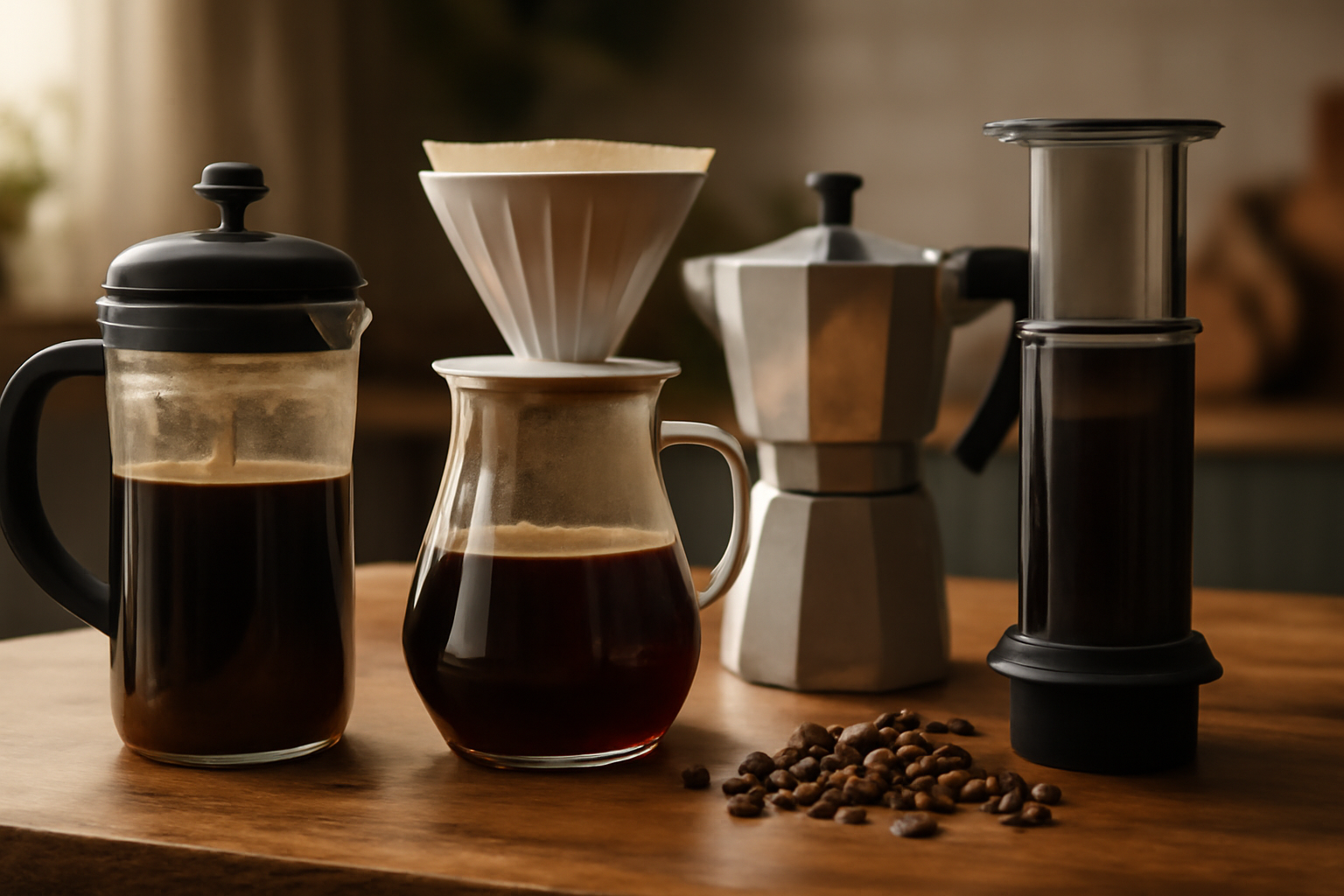Coffee is a deeply personal beverage, with the brewing method playing a significant role in its flavor, strength, and overall experience. From the robust intensity of espresso to the delicate brew of pour-over coffee, each method offers a unique way to enjoy this beloved drink. With so many brewing techniques available, choosing the best one for your taste can be overwhelming. Whether you prefer a smooth, mild cup or a strong, bold brew, this guide will help you explore the most popular coffee brewing methods and how to select the right one for your preferences.
1. The Essence of Coffee Brewing: What Happens During Extraction?
Before diving into specific methods, it’s important to understand the basic principle of coffee brewing. Brewing coffee is the process of extracting the flavors and oils from the coffee grounds and infusing them into the water. The method you use controls the time, temperature, and pressure involved in extraction, and these factors determine how much flavor is extracted from the beans.
Different brewing methods have varying levels of extraction, with some extracting more oils, others focusing on clarity, and some enhancing body or strength. Understanding the basics of extraction will help you choose the best method based on the kind of coffee experience you’re looking for.
2. Espresso: The Strong and Bold Choice
Espresso is the foundation of many coffee drinks, from lattes to cappuccinos and macchiatos. It’s brewed by forcing hot water through finely ground coffee under high pressure. The result is a small, concentrated shot of coffee with a thick, velvety crema on top.
Why Choose Espresso?
- Strong flavor: Espresso delivers a bold, rich flavor in every shot. If you love intense, full-bodied coffee, espresso is the way to go.
- Quick brewing: It only takes about 25-30 seconds to brew an espresso shot, making it one of the fastest methods.
- Versatility: Once you’ve mastered espresso, you can use it as the base for a variety of drinks, such as lattes, cappuccinos, and Americanos.
Considerations:
- Equipment: Espresso requires a specialized espresso machine or a stovetop Moka pot. You’ll also need a coffee grinder that can grind the beans to a fine consistency.
- Skill: Brewing a perfect espresso can take practice, especially when it comes to getting the grind size and extraction time just right.
3. French Press: A Rich and Full-Bodied Brew
The French press is one of the most popular methods of brewing coffee, thanks to its ability to produce a rich, full-bodied cup. This method involves steeping coarsely ground coffee beans in hot water and then pressing the grounds with a plunger to separate them from the brewed coffee.
Why Choose French Press?
- Rich flavor: The French press allows the coffee to steep, extracting more oils and flavor from the beans. This results in a fuller, more robust cup of coffee.
- Full control: You can adjust the brewing time and the coffee-to-water ratio to suit your preferences.
- Simplicity: The French press doesn’t require any fancy equipment beyond the press itself. It’s easy to use and clean.
Considerations:
- Coarse grind: For the best results, you’ll need a coffee grinder that can produce a coarse grind. A fine grind can lead to over-extraction and a bitter flavor.
- Brew time: The French press typically brews for 4-5 minutes, which may not be ideal for those who prefer a quick cup.
4. Pour-Over: The Art of Manual Brewing
Pour-over brewing is an artisanal method that involves pouring hot water over coffee grounds in a filter. This method requires patience, but it allows you to control the rate of extraction and achieve a clean, flavorful cup of coffee. Popular pour-over devices include the Chemex and the Hario V60.
Why Choose Pour-Over?
- Precision: Pour-over brewing allows you to control the flow rate and water temperature, giving you more control over the extraction process and flavor.
- Clean taste: Because the coffee is filtered, the result is a clean, crisp cup with clear flavors.
- Customization: The pour-over method is perfect for experimenting with different brew times and grind sizes to suit your preferences.
Considerations:
- Manual effort: Pour-over brewing requires your full attention and manual pouring, which can be time-consuming.
- Filters: You’ll need to buy paper filters, and they must be discarded after each use, which may not be ideal for those looking for a low-maintenance option.
5. AeroPress: Quick, Smooth, and Portable
The AeroPress is a compact, portable brewing device that uses air pressure to push hot water through coffee grounds. It’s known for its ability to brew a smooth cup of coffee with a rich, espresso-like flavor, but without the need for a bulky machine. The AeroPress is also versatile—it can be used to make both regular coffee and espresso-style drinks.
Why Choose AeroPress?
- Fast brewing: AeroPress brews coffee in just about 2 minutes, making it an excellent option for those who want a quick and flavorful cup.
- Portable: It’s lightweight and easy to pack, making it ideal for travel, camping, or enjoying a cup on the go.
- Customizable: You can experiment with different coffee-to-water ratios, grind sizes, and brewing times to find the flavor profile that suits you best.
Considerations:
- Requires a grinder: The AeroPress works best with freshly ground coffee, so you’ll need a grinder that can achieve a medium-fine grind.
- Small batch: The AeroPress can only brew one to two cups at a time, which may not be ideal for larger groups.
6. Cold Brew: Smooth and Refreshing
Cold brew coffee is made by steeping coarsely ground coffee in cold water for 12-24 hours, resulting in a smooth, low-acid coffee concentrate. After steeping, the grounds are filtered out, and the resulting brew can be diluted with water or milk.
Why Choose Cold Brew?
- Low acidity: Cold brew coffee is naturally lower in acidity than hot-brewed coffee, making it easier on the stomach.
- Smooth, rich flavor: The slow brewing process extracts smooth, chocolatey flavors, with less bitterness than traditional brewing methods.
- Convenience: Once brewed, cold brew concentrate can be stored in the fridge for up to two weeks, providing a refreshing and ready-to-drink coffee option.
Considerations:
- Time-consuming: Cold brew requires a long steeping time (12-24 hours), so it’s not ideal for those looking for a quick brew.
- Large batch: Cold brew is typically made in larger quantities, which may not be necessary for those who only drink one or two cups a day.
7. Moka Pot: A Strong, Espresso-Like Brew
The Moka pot is an Italian stovetop coffee maker that brews coffee by forcing water through coffee grounds using steam pressure. It produces a strong, espresso-like coffee, though it is not technically espresso due to the lower pressure.
Why Choose Moka Pot?
- Rich flavor: The Moka pot creates a coffee with a strong, bold flavor similar to espresso, making it perfect for those who love intense coffee.
- Affordable: Moka pots are relatively inexpensive and require no electricity, making them a cost-effective way to brew high-quality coffee.
- Compact: Like the AeroPress, Moka pots are small and portable, making them great for travel or small kitchens.
Considerations:
- Pressure: While the Moka pot brews strong coffee, it doesn’t create the same crema as a true espresso machine.
- Requires attention: Brewing with a Moka pot requires careful monitoring to avoid burning the coffee or causing the pot to overflow.
Conclusion: Find the Method That Suits Your Taste
Choosing the best coffee brewing method is all about personal preference. Whether you love the rich, bold flavor of espresso, the smoothness of a French press, or the precision of pour-over brewing, there’s a method that will give you the perfect cup of coffee every time. By understanding each method’s strengths and considering your own preferences for flavor, convenience, and brewing time, you can discover the method that works best for you.

I’m an economist with 15 years of experience in strategic planning and a lifelong passion for wellness and natural living. As a self-learner, I created Herbalife Balance to share insights on healthy eating, mindful habits, and an active lifestyle. Tennis enthusiast and nature lover, I believe in balance as a path to well-being. Through this blog, I help others live healthier, more conscious lives.

